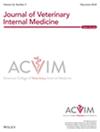Urine Neutrophil Gelatinase-Associated Lipocalin in Non-Associative Immune Mediated Hemolytic Anemia: A Prospective Controlled Study in 22 Dogs
Abstract
Background
Urine neutrophil gelatinase-associated lipocalin (uNGAL) is a biomarker for the early diagnosis of AKI.
Objectives
To evaluate uNGAL in dogs with non-associative immune mediated hemolytic anemia (IMHA) and to evaluate whether uNGAL correlates with disease severity markers, negative prognostic indicators and outcome.
Animals
Twenty-two dogs with non-associative IMHA and 14 healthy dogs.
Methods
Prospective case–control study. uNGAL was measured by a commercially available ELISA-kit and corrected to urine creatinine (uNGAL to creatinine ratio [UNCR]). uNGAL and UNCR of IMHA cases were compared to that of healthy dogs and the correlation with other clinicopathological markers was evaluated. uNGAL and UNCR were also compared between dogs with a CHAOS or ASA score < 3 and ≥ 3.
Results
uNGAL and UNCR were significantly higher in dogs with IMHA when compared to healthy controls (uNGAL median 114.58 and 0.43 ng/mL, respectively, p < 0.001; UNCR median 174.87 and 0.13 ng/mg, respectively, p < 0.001). uNGAL and UNCR were moderately positively correlated with urea (p = 0.005, r = 0.58, 0.20–0.81 95% CI and p = 0.001, r = 0.64, 0.29–0.84 95% CI, respectively) and total bilirubin (p = 0.003, r = 0.60, 0.22–0.82 95% CI and p = 0.002, r = 0.62, 0.25–0.83 95% CI, respectively). These were also significantly higher in dogs with hemoglobinuria compared to those without (uNGAL: median 269 and 30.99 ng/mL, respectively, p < 0.001; UNCR: median 585.3 and 352 37.47 ng/mg, respectively, p < 0.001). There was no statistically significant difference in uNGAL or UNCR when assessing survival to discharge (p = 0.24 and p = 0.16, respectively, 95% CI).
Conclusions
This study suggests that renal injury might be underappreciated in dogs with IMHA.


 求助内容:
求助内容: 应助结果提醒方式:
应助结果提醒方式:


